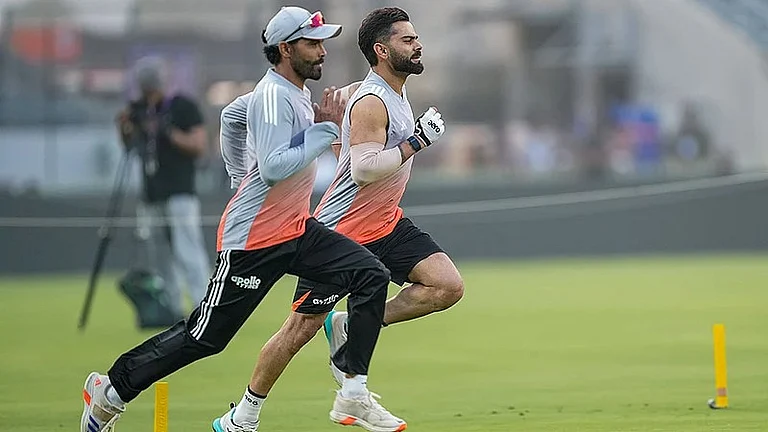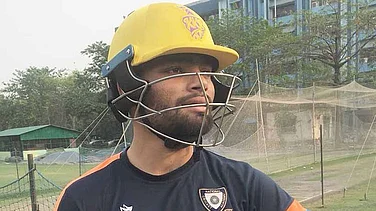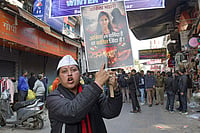Indian cricket is at a turning point. The stars are changing, the centres are shifting, and the stories no longer start where they used to. Rohit Sharma and Virat Kohli are out of their Test whites. Dhoni may never return to the crease in yellow. The centre of gravity in the sport is shifting. The new face of Indian cricket is not defined by endorsement deals or clubhouse politics. It is not born in a Mumbai academy or Delhi nets. It is shaped in cramped mohallas, in cricket-starved districts, in schools without facilities and clubs without kits. Today, cricket's rawest, hungriest talent is emerging from India's margins.
Outlook's next issue, Innings/Outings, looks beyond the farewell statements and retirement montages to ask what comes next. Who takes the strike now, and on whose terms?
Harsh Kumar captures this new geography of power in his piece on rising players from small towns and underprivileged backgrounds. The journeys of cricketers like Yashasvi Jaiswal, T. Natarajan, and Mohammed Siraj tell us that the next Indian team will not just be selected differently. It will be imagined differently. Kumar writes, "Indian cricket's rawest talent isn't coming from academies in metros. It's coming from the margins."
But as cricket spreads out, old inequalities follow. In an investigative report, Pragya Singh turns the spotlight on caste and asks why the sport, unlike politics or education, continues to erase the identities of those who play it. There are no quotas, no diversity metrics, and no public conversations about representation. "In Indian cricket, talent is celebrated, but silence is institutional," she writes. The myth of meritocracy is held up not by fairness, but by forgetting.
Minal Tomar shifts the frame further, exploring how Indian women cricketers carved a space for themselves in a game that rarely saw them. She writes of packed WPL stadiums and endorsement deals, yes. But she also documents the generational resistance that came before it. "This wasn't just cricket. It was quiet defiance in motion, a revolution wrapped in resilience."
From the Northeast, Sangmuan Hangsing examines how new infrastructure and BCCI investment are reshaping cricket in states like Manipur and Nagaland. Can a sport that once felt distant to the northeast be made truly local? "Inclusion by infrastructure is not the same as belonging," he warns.
And in Bihar, Md Asghar Khan finds 14-year-old Vaibhav Suryavanshi. A boy whose name now echoes across Samastipur and beyond. He practises in a cricket-starved district and yet finds himself in elite national tournaments.
In the essays by R. Kaushik and Suresh Menon, we return to the question of legacy. What kind of leaders were Kohli and Rohit, and what did they leave behind? Kaushik notes that Kohli didn't repeat a playing XI in his first 27 Tests. Rohit, by contrast, was a tactician who stayed calm under fire. Between them, they built a system that could absorb their exits. "That, despite the sudden retirements within a week of Rohit and Kohli, they are still able to put out a formidable outfit is a testament to the depth that the well-crafted system has provided."
Menon stretches the timeline further, from Kapil to Kohli, Doordarshan to Disney+. His essay is a reminder that cricket has always been a mirror to India: reflecting its contradictions, its transformations, and its sense of self.
And then there's the IPL. The 2008 experiment that became a cultural juggernaut. Bhuvan Gupta writes of its resilience: "Crippling issues come and go, but nothing truly derails the Indian Premier League." In his telling, the IPL is no longer just a tournament. It's a prism through which cricket and its compromises are refracted.
Mukul Kesavan captures its spectacle with a sharp eye: “The IPL is a two-month, 74-episode soap with a guaranteed climax.” He argues that the IPL and T20 cricket have “invented a simplified, sixer-happy version of the game where pehalwan hitters perform for look-at-me stadium fans and look-at-anything television audiences trying to escape the alienation of their working lives." Bleaching the sport of the cunning subtlety, and skill that made Test cricket such a sophisticated contest.
In Innings/Outings, we trace a sport in transition. Where once power sat comfortably with a few urban clubs, it is now moving restlessly across geographies and classes. Where once identity was flattened into "Indian cricketer," it now demands more complex recognition. Where once cricket was a national obsession, it is now an uneven, multi-sited ecosystem—a game of many Indias.
Some are walking out. Others are being sent in. The innings is far from over.


























